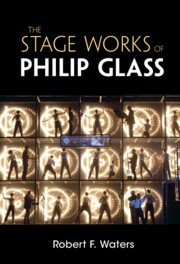Book contents
- The Stage Works of Philip Glass
- The Stage Works of Philip Glass
- Copyright page
- Dedication
- Contents
- Figures
- Tables
- Music Examples
- Selected Stage Works of Philip Glass
- Preface
- Acknowledgments
- Part I Background
- Part II Stage Works
- Chapter 5 Theater
- Chapter 6 Language and Philosophy
- Chapter 7 Themes, Genres, and Archetypes
- Chapter 8 Multimedia and Hybrid Genres
- Chapter 9 Dance
- Chapter 10 Music
- Chapter 11 Critical and Audience Reception
- Chapter 12 Conclusion
- Notes
- Select Bibliography
- Index
Chapter 8 - Multimedia and Hybrid Genres
from Part II - Stage Works
Published online by Cambridge University Press: 21 July 2022
- The Stage Works of Philip Glass
- The Stage Works of Philip Glass
- Copyright page
- Dedication
- Contents
- Figures
- Tables
- Music Examples
- Selected Stage Works of Philip Glass
- Preface
- Acknowledgments
- Part I Background
- Part II Stage Works
- Chapter 5 Theater
- Chapter 6 Language and Philosophy
- Chapter 7 Themes, Genres, and Archetypes
- Chapter 8 Multimedia and Hybrid Genres
- Chapter 9 Dance
- Chapter 10 Music
- Chapter 11 Critical and Audience Reception
- Chapter 12 Conclusion
- Notes
- Select Bibliography
- Index
Summary
Glass was initially inspired to compose multimedia stage works by watching avant-garde theater productions in Europe, after which he composed incidental music for an ensemble later known as Mabou Mines. Director–designer Robert Wilson had a strong impact on Glass’s multimedia stage works, primarily with Wilson’s Theater of Images, which highlighted geometrically angular shapes coupled with evocative light patterns and stage designs. Wilson also incorporated surrealistic dreamlike images and otherworldly body movements.
Glass’s multimedia stage works often include these features, using film, slides, photographs, graphic design, computer animation, and videos. He subsequently composed music for film directors Martin Scorsese and Woody Allen and for dancer–choreographers Lucinda Childs, Jerome Robbins, and Twyla Tharp. Glass also composed three “multimedia film operas” based on films by Jean Cocteau. For La belle et la bête, Glass composed music (1994) for live singers to be performed with Cocteau’s film instead of the original soundtrack. Glass’s opera Monsters of Grace (1997) is a surrealist three-dimensional video computer graphics work with stereoscopic animation, in which eight of the scenes are to be watched with polarized lenses. The work includes “synthespians” with three-dimensional animated heads scanned from those of actual actors.
- Type
- Chapter
- Information
- The Stage Works of Philip Glass , pp. 128 - 150Publisher: Cambridge University PressPrint publication year: 2022



